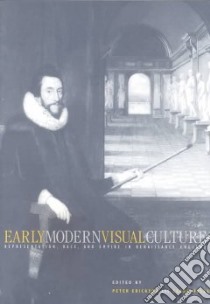- Libreria
- >
- Libri in lingua
- >
- Studi interdisciplinari
- >
- Studi interdisciplinari
Early Modern Visual Culture - 9780812217346
Un libro in lingua di Erickson Peter (EDT) Hulse Clark (EDT) edito da Univ of Pennsylvania Pr, 2000
- € 32.30
- Il prezzo è variabile in funzione del cambio della valuta d’origine
An interdisciplinary group of scholars applies the reinterpretive concept of "visual culture" to the English Renaissance. Bringing attention to the visual issues that have appeared persistently, though often marginally, in the newer criticisms of the last decade, the authors write in a diversity of voices on a range of subjects. Common among them, however, is a concern with the visual technologies that underlie the representation of the body, of race, of nation, and of empire.
Several essays focus on the construction and representation of the human body—including an examination of anatomy as procedure and visual concept, and a look at early cartographic practice to reveal the correspondences between maps and the female body. In one essay, early Tudor portraits are studied to develop theoretical analogies and historical links between verbal and visual portrayal. In another, connections in Tudor-Stuart drama are drawn between the female body and the textiles made by women. A second group of essays considers issues of colonization, empire, and race. They approach a variety of visual materials, including sixteenth-century representations of the New World that helped formulate a consciousness of subjugation; the Drake Jewel and the myth of the Black Emperor as indices of Elizabethan colonial ideology; and depictions of the Queen of Sheba among other black women "present" in early modern painting. One chapter considers the politics of collecting. The aesthetic and imperial agendas of a Van Dyck portrait are uncovered in another essay, while elsewhere, that same portrait is linked to issues of whiteness and blackness as they are concentrated within the ceremonies and trappings of the Order of the Garter.
All of the essays in Early Modern Visual Culture explore the social context in which paintings, statues, textiles, maps, and other artifacts are produced and consumed. They also explore how those artifacts—and the acts of creating, collecting, and admiring them—are themselves mechanisms for fashioning the body and identity, situating the self within a social order, defining the otherness of race, ethnicity, and gender, and establishing relationships of power over others based on exploration, surveillance, and insight.
Informazioni bibliografiche
- Titolo del Libro in lingua: Early Modern Visual Culture
- Sottotitolo: Representation, Race, Empire in Renaissance England
- Lingua: English
- Autori : Erickson Peter (EDT) Hulse Clark (EDT)
- Editore: Univ of Pennsylvania Pr
- Collana: Univ of Pennsylvania Pr (Paperback)
- Data di Pubblicazione: 01 Novembre '00
- Genere: ART
- Argomenti : Arts, English Art and society England Renaissance England
- Dimensioni mm: 254 x 184 x 19
- ISBN-10: 0812217349
- EAN-13: 9780812217346


